Unlock User-Centered Insights with StoryMap.site: Streamline Product Development with Visual Story Mapping


Unlock User-Centered Insights with StoryMap.site: Streamline Product Development with Visual Story Mapping
In the fast-paced realm of product development, understanding user needs is paramount. Enter StoryMap.site, a revolutionary tool designed to streamline the process through Visual Story Mapping. This article delves into the significance of Story Maps, their historical roots, and how StoryMap.site can be your compass in creating user-centric products.
What is a Story Map?
A User Story Map is more than just a visual aid; it’s a dynamic tool capturing the essence of how real users interact with your product. Organized horizontally by user activities and vertically by priority, it provides a holistic view of a product’s functionality. This method of visualization gained prominence in 2005 when Jeff Patton introduced User Story Mapping, solidifying its status as a standard in Agile and UX/UI fields. Notably, companies like Atlassian and Gitlab harness the power of Story Maps in their development processes.
Understanding StoryMap.site
At the core of StoryMap.site is simplicity. The platform utilizes plain text input to swiftly craft a map, making it accessible to everyone involved in the product development lifecycle. Let’s take a closer look at how StoryMap.site works through a practical example.
Example: Persona – James, a busy professional
Activity: Order a ride
- Step: Open app
- Story: Log in to my account
- Story: Log in with face-id
- Step: Request a ride
- Story: Set pickup location
- Story: Select ride type (UberX, UberPool etc.)
- Story: See ETA for each ride type
- Story: Set destination
- Step: Track driver
- Story: See driver’s name, photo, vehicle details
- Story: View real-time location of driver on map
- Story: Get notified when driver is late
- Step: Take ride
- Story: Get notified when driver arrives
- Story: Rate driver and provide feedback after the trip
This example showcases the flexibility of StoryMap.site, allowing for the inclusion of emojis to convey essential information. For instance, green indicates key steps, while emojis can represent frustration points, releases, or priority.
How to Use StoryMap.site
Step 1: Assemble the Team
Gather your product development team, including designers, developers, product owners, and stakeholders.
Step 2: Identify User Personas
Understand your users’ goals, problems, and personas.
Step 3: Define the Backbone of the Story
Identify key activities (blue cards) and steps (green cards) horizontally on the map.
Step 4: Brainstorm User Stories
For each step (green card), list associated user stories (yellow cards) detailing specific tasks.
Step 5: Prioritize Stories
Rank stories vertically based on priority, ensuring critical functionalities take precedence.
Explore StoryMap.site and empower your team to visualize, prioritize, and deliver user-centered products seamlessly.
Enhancing Your Development Workflow
Incorporate StoryMap.site into your development workflow and witness the transformation in how you understand and respond to user needs. Check out this insightful video for a guided tour.
Ready to unlock user-centered insights? Dive into the world of StoryMap.site and revolutionize your product development journey!





